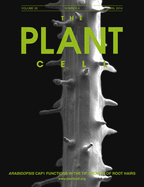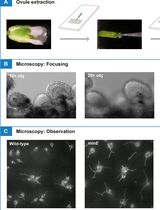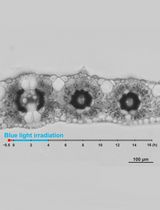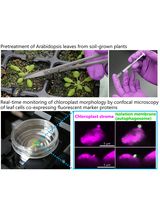- EN - English
- CN - 中文
Quantitative Image Analysis of Membrane Microdomains Labelled by Fluorescently Tagged Proteins in Arabidopsis thaliana and Nicotiana benthamiana
定量图像分析拟南芥和本氏烟草中荧光标记蛋白质示踪的膜微区
发布: 2015年06月05日第5卷第11期 DOI: 10.21769/BioProtoc.1497 浏览次数: 10023
评审: Arsalan DaudiRenate WeizbauerAnonymous reviewer(s)
Abstract
We have recently characterized co-existing membrane microdomains that are labeled by different proteins in living plant cells (Jarsch et al., 2014). For this approach we first created a digital fingerprint for each of the twenty marker proteins using quantitative image analysis. Here we recorded parameters such as domain size, density and shape based on image segmentation. We found highly reproducible patterns of any of the proteins over a large number of biological replicates. Furthermore we exclusively acquired images from lowly expressing cells and chose our imaging conditions in a way that resulted in images where no pixel was saturated.
This protocol describes in detail the methods that have been used to analyze quantitative differences in localization of members of the remorin protein family in membrane microdomains of Arabidopsis thaliana and Nicotiana benthamiana (Jarsch et al., 2014). The proteins were either individually or pairwise expressed as fluorophore fusions in the respective plant. Image acquisition was performed using standard Confocal Laser Scanning Microscopy (CLSM) and image analysis was performed using ImageJ.
[Introduction] Since confocal laser-scanning or other state-of-the-art fluorescence microscopes are nowadays often regarded as standard equipment a modern research institution should have, the amount of published cell biological data has massively increased over the last years. This certainly also correlates with the availability of an increasing number of fluorophores and corresponding expression vectors that have made it comparably easy to generate large numbers of tagged proteins. One main concern about showing microscopy images in publications is the subjectivity they have been selected with. In addition, and certainly very unfortunate in several cases, the scientific community as well as reviewers of manuscripts have requested ‘no background-high fluorescence’ images from the authors. As a consequence researchers often started selecting the images based on aesthetic aspects rather than showing the most representative ones. Furthermore the majority of images are based on strong over-expression of proteins. Therefore quantitative image analysis has become an absolute requirement in order to make robust statements on cell biological observations and the frequency with which they have been observed. However, this does not only require gaining novel skills but also high numbers of biological repetitions in a standardized way. Furthermore, it should be the ultimate goal to work under conditions where the protein of interest is expressed at native levels. While this may have to be overcome for lowly abundant proteins, researchers should nevertheless aim for similar levels and may thus accept more background noise in the images.
It should be noted that all parameters and protocol specifications provided within this protocol have been optimized for the expression we used in a current study (Jarsch et al., 2014). Most likely they have to be adapted for any analyses in different laboratories.
Materials and Reagents
- 4-5 weeks old Nicotiana benthamiana (N. benthamiana) plants (soil grown)
- 4-5 weeks individually potted stable transgenic Arabidopsis thaliana (A. thaliana) lines expressing AvrPto under control of a dexamethasone (DEX)-inducible promoter as described previously (Hauck et al., 2003; Tsuda et al., 2012) (lines available upon request from the authors of the original publication) (soil grown)
- Agrobacterium strains
- GV3101 C58 mp90RK for constructs in pAM-PAT:35S and pH7YGW2
- Agl1 for constructs in pUbi and pGWB1-based vectors
- GV3101 C58 mp90RK for constructs in pAM-PAT:35S and pH7YGW2
- MgCl2 (Carl Roth, catalog number: 2189 )
- MES KOH (pH 5.6) (Carl Roth, catalog number: 4256.2 )
- Acetosyringone (Sigma-Aldrich, catalog number: D134406 )
- Dexamethasone (Sigma-Aldrich, catalog number: D4902 )
- EtOH
- Silwett L-77 (Leu+Gygax AG, catalog number: CH-SL7-033-01 )
- Infiltration solution for Agrobacterium tumefaciens-mediated transient transformation of N. benthamiana or A. thaliana (see Recipes)
- DEX-solution for pre-treatment of AvrPto-DEX inducible A. thaliana (see Recipes)
Equipment
- Table-top centrifuge for 2 ml tubes (Eppendorf, model: 5424 )
- Spectrometer (Pharmacia Biotech (now: GE Healthcare, Ultrospec 3000 pro)
- 1 ml syringes (Braun catalog number: 9161406V )
- 2 ml reaction tubes for centrifugation (SARSTEDT AG, catalog number: 72.695.500 )
- 50 ml spray flask (Carl Roth, Karlsruhe, catalog number: EP66 )
- 4 mm biopsy punch or similar tool (cork borer) to excise leaf discs (recommended: Produkte für Medizintechnik (pfm), 4 mm, catalog number: 49401 )
- Microscope cover glasses (Carl Roth, 24 x 60 mm, #1,5 (170 micron), catalog number: H878 )
- Microscope slides (Langenbrick, 76 x 26 x 1 mm, catalog number: 03-0010/90 )
- Confocal microscope (Leica Microsystems, model: SP5 )
- Leica DFC350FX digital camera
- Objectives used for this experiment: HC PL APO 20x/0.70 ImmCorr CS and HCX PL APO 63x/1.20 W CORR CS)
- Excitation using an argon laser (100 mW, Lasos LGK 7872 ML05 SP5) [for YFP: 514 nm (excitation), 525-600 nm (emission); for CFP: 456 nm (excitation); 475-620 nm (emission)]
Software
- ImageJ (Plug-in supplemented version: Fiji)
- Intensity Correlation Analysis Bundle from the Wright Cell Imaging Facility (WCIF Image) (Li et al., 2004)
Procedure
文章信息
版权信息
© 2015 The Authors; exclusive licensee Bio-protocol LLC.
如何引用
Jarsch, I. K. and Ott, T. (2015). Quantitative Image Analysis of Membrane Microdomains Labelled by Fluorescently Tagged Proteins in Arabidopsis thaliana and Nicotiana benthamiana. Bio-protocol 5(11): e1497. DOI: 10.21769/BioProtoc.1497.
分类
植物科学 > 植物细胞生物学 > 细胞成像
生物化学 > 蛋白质 > 荧光
细胞生物学 > 细胞成像 > 共聚焦显微镜
您对这篇实验方法有问题吗?
在此处发布您的问题,我们将邀请本文作者来回答。同时,我们会将您的问题发布到Bio-protocol Exchange,以便寻求社区成员的帮助。
Share
Bluesky
X
Copy link













